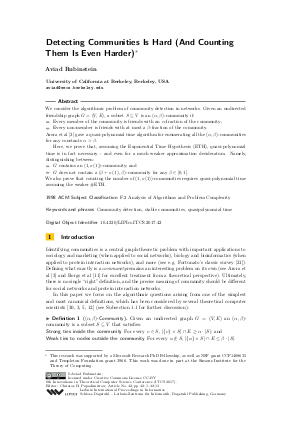Detecting communities is Hard (And Counting Them is Even Harder)
Author Aviad Rubinstein
-
Part of:
Volume:
8th Innovations in Theoretical Computer Science Conference (ITCS 2017)
Part of: Series: Leibniz International Proceedings in Informatics (LIPIcs)
Part of: Conference: Innovations in Theoretical Computer Science Conference (ITCS) - License:
 Creative Commons Attribution 3.0 Unported license
Creative Commons Attribution 3.0 Unported license
- Publication Date: 2017-11-28
File

PDF
LIPIcs.ITCS.2017.42.pdf
- Filesize: 0.55 MB
- 13 pages
Document Identifiers
Subject Classification
Keywords
- Community detection
- stable communities
- quasipolynomial time
Metrics
- Access Statistics
-
Total Accesses (updated on a weekly basis)
0PDF Downloads0Metadata Views
Abstract
We consider the algorithmic problem of community detection in networks. Given an undirected friendship graph G, a subset S of vertices is an (a,b)-community if: * Every member of the community is friends with an (a)-fraction of the community; and * every non-member is friends with at most a (b)-fraction of the community. [Arora, Ge, Sachdeva, Schoenebeck 2012] gave a quasi-polynomial time algorithm for enumerating all the (a,b)-communities for any constants a>b. Here, we prove that, assuming the Exponential Time Hypothesis (ETH), quasi-polynomial time is in fact necessary - and even for a much weaker approximation desideratum. Namely, distinguishing between: * G contains an (1,o(1))-community; and * G does not contain a (b,b+o(1))-community for any b. We also prove that counting the number of (1,o(1))-communities requires quasi-polynomial time assuming the weaker #ETH.
Cite As Get BibTex
Aviad Rubinstein. Detecting communities is Hard (And Counting Them is Even Harder). In 8th Innovations in Theoretical Computer Science Conference (ITCS 2017). Leibniz International Proceedings in Informatics (LIPIcs), Volume 67, pp. 42:1-42:13, Schloss Dagstuhl – Leibniz-Zentrum für Informatik (2017)
https://doi.org/10.4230/LIPIcs.ITCS.2017.42
BibTex
@InProceedings{rubinstein:LIPIcs.ITCS.2017.42,
author = {Rubinstein, Aviad},
title = {{Detecting communities is Hard (And Counting Them is Even Harder)}},
booktitle = {8th Innovations in Theoretical Computer Science Conference (ITCS 2017)},
pages = {42:1--42:13},
series = {Leibniz International Proceedings in Informatics (LIPIcs)},
ISBN = {978-3-95977-029-3},
ISSN = {1868-8969},
year = {2017},
volume = {67},
editor = {Papadimitriou, Christos H.},
publisher = {Schloss Dagstuhl -- Leibniz-Zentrum f{\"u}r Informatik},
address = {Dagstuhl, Germany},
URL = {https://drops.dagstuhl.de/entities/document/10.4230/LIPIcs.ITCS.2017.42},
URN = {urn:nbn:de:0030-drops-81496},
doi = {10.4230/LIPIcs.ITCS.2017.42},
annote = {Keywords: Community detection, stable communities, quasipolynomial time}
}
